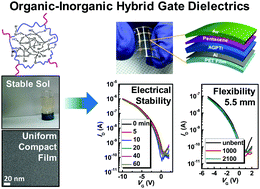A critical role of amphiphilic polymers in organic–inorganic hybrid sol–gel derived gate dielectrics for flexible organic thin-film transistors†
Abstract
The sol–gel method is a low-temperature, highly controllable and cost-effective method for producing homogeneous and high-quality ultrafine nanostructured thin films. Despite these advantages, sol–gel derived gate dielectrics have received little attention. Here, we synthesized a sol–gel derived organic–inorganic (O–I) hybrid gate dielectric (AGPTi) and demonstrated the stability and flexibility of organic thin-film transistors (OTFTs) made with it. The AGPTi film was simply fabricated from three conventional precursors, namely (3-glycidyloxypropyl)trimethoxysilane (GPTMS), propyltrimethoxysilane (PTMS), and titanium(IV) isopropoxide (TTiP), and a newly synthesized alkoxysilane-functionalized amphiphilic polymer (AFAP) under mild conditions (120 °C for 60 min). This research revealed several important benefits of including such an amphiphilic polymer in sol–gel derived O–I hybrid gate dielectrics: a considerable enhancement of sol stability; an ability to achieve a high-quality thin film with elaborate structures of small nanoclusters; and a dramatic improvement of adhesion, leakage current density of gate dielectrics, electrical stability and flexibility of devices. We expect this study to open up new applications for O–I hybrid materials in flexible electronics.



 Please wait while we load your content...
Please wait while we load your content...